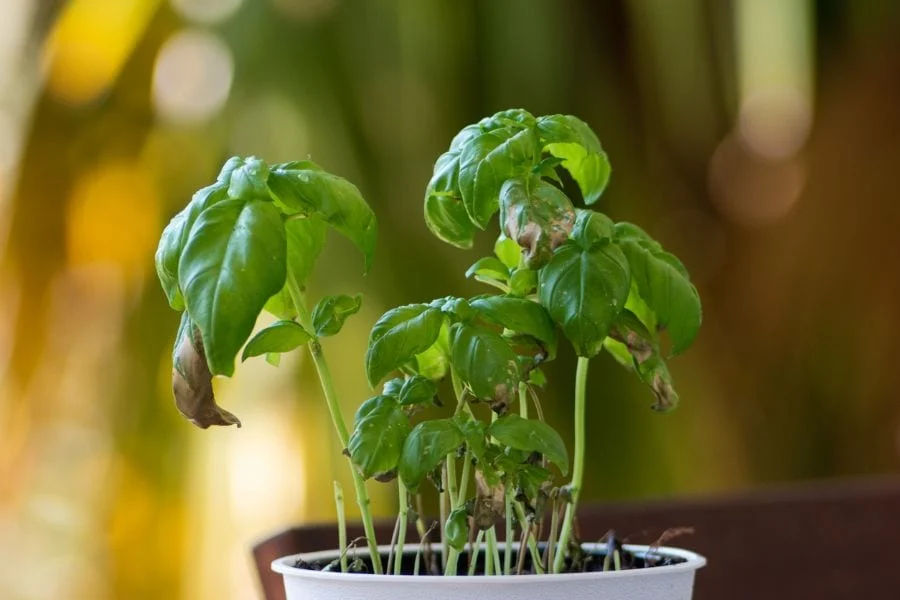Basil plants can grow both outdoors and in plant pots. With the arrival of the season, many housewives plant basil in their flower beds or plant pots, so that they always have fresh basil leaves to prepare or decorate their dishes.
Basil is a tropical, herbaceous plant that requires proper care. The soil should be constantly moderately moistened.
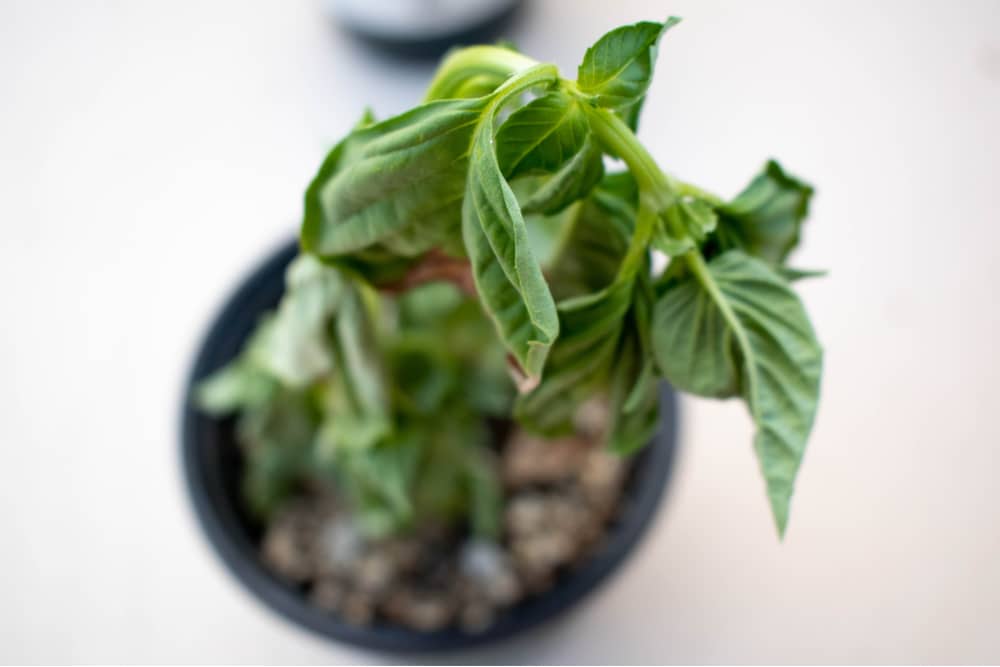
The more often you cut basil leaves, the more they will appear. The plant won’t grow in height, but in width, so more leaves will get enough full sun to grow and develop well. Also, basil should be grown in well-lit areas, under direct sunlight.
Note: basil is a seasonal plant and no matter how beautiful it is in summer, with the onset of cold weather, basil leaves will wither.
But, if you noticed that the basil began to wilt prematurely, the leaves bent or began to curl, the edges of the leaves turned black or spots appeared on them, then your basil needs immediate help because several reasons can worsen the appearance of the plant and lead to death.
Wilting basil leaves are not used in cooking!
Contents
Why is my indoor basil plant dying? Common reasons
- Incorrect watering:
- Too little water (underwatering)
- Too much water (overwatering)
- Too little space/ too small pot
- Transplant shock
- The rapid change in temperature conditions
- Not regular pruning
- Diseases that affected leaves or roots
- Pests
Incorrect watering
You can plant basil in your herb garden, but more comfortable to plant it in a pot for better control over the general condition of your plant and the soil.
The basil plant is a moisture-loving plant. The soil must be consistently moist. Drying out of the soil will lead to wilting basil. But, certain that the moist soil is moderate.
If you watered the plant and the roots were in watery soil for some time, this can bring the basil plant wilting.
Let’s get acquainted in more detail with the problems associated with the improper watering of basil plants.

Too little water (underwatering)
Basil is a light-loving plant that grows best in the full sun. If the watering frequency is not enough, the soil dries out and the basil plant begins to wither or even turn yellow. Hanging, wilting basil leaves are a sign of insufficient watering or dry soil. Drooping leaves also indicate insufficient watering.
This is easy to detect. If it’s potted basil, look under the leaves. If the soil has moved away from the walls of the pot, then the soil is too dry and the wilted basil plant should be watered immediately.
In this case, you can easily correct the situation by correcting the watering schedule and reviving your basil. Water the soil thoroughly and check the condition of the plant carefully for some days.
Water basil under its roots. Overhead watering causes leaf burns, fusarium wilt, appearance, and the reproduction of powdery mildew, or other fungal diseases.
In many cases, a couple of days in consistently moist soil and leaf growth will recover again. If a few days of moderate watering didn’t fix the situation and the basil didn’t get better, then it’s necessary to take care of mulching the soil.
Spread the mulch over the soil in the pot, or around the base of the basil plant if it’s vegetating in the garden.
Manure or rotted leaves will retain moisture well, keep the soil cool and thus lessen evaporation and prevent the soil from drying out.
Compost and frequent watering will help you maintain your healthy basil plant over the growing season. These tips are especially relevant for very hot regions, or if an extreme heat wave is expected. Take care of your basil in advance, or, in case of unexpectedly hot weather, at least bring the basil into the shade for a while.
Too much water (overwatering)
If trying to maintain constant soil moisture, you can overwater the basil plant. Remember: basil grows well in moderately moist soil, not in soggy soil or boggy soil.
If the roots of the plant remain in the watery soil for a long time, the plant is wilting, turning yellow, or droop because the constantly wet soil prevents oxygen from reaching the roots, which brings root rot and basil wilting.
If you think the basil was overwatered, don’t water it for a certain time, allow the soil dry completely. How to control the soil for moisture or dryness? Stick your finger in the soil. If the soil is dry, water the basil immediately.
If the soil is wet, then the problem can’t be solved simply by not watering.
Consider repotting the basil into a larger pot if it’s growing indoors. If you grow basil outside, on poor drainage soil or waterlogged soil (for example, clay), then it is also worth transplanting it into a pot.
The pot must be large enough because it will fit more soil. Also, take care of fitting drainage. Check that there are holes in the bottom of the pot and that there are enough of them. If not, increase the number of bottom holes so that excess moisture is not retained, but is well drained.
Drainage holes help maintain a balance between hydration and drainage of excess water. When transplanting, you can use compost from a garden center.
Multipurpose compost is both moisture-retentive, which will prevent the soil from drying out, and free of pathogens found in regular soil, which will also prevent the establishment and spread of disease and fusarium wilt of basil.
If basil is growing in a pot with proper drainage holes, and the soil is still very wet, it is better to avoid using a drip tray. Sure, the drip tray retains moisture so that it does not spill onto windowsills or furniture and spoil them. But at the same time, retention of excess water leads to waterlogging of the soil and drooping basil plant.
When you want to water basil, take it outside, water it thoroughly, let excess moisture drain, and only then bring it back indoors. You can also put a towel under the bottom of the pot for some time, which will mop up excess moisture and help protect the furniture.
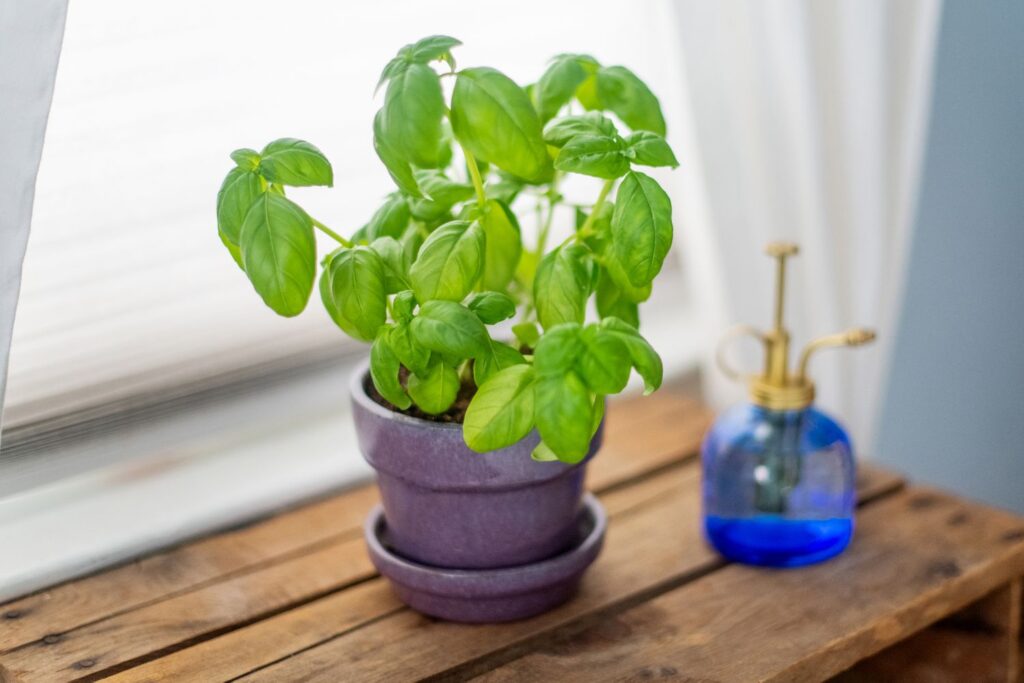
Too little space/ too small pot/ incorrect pot
Basil plant drooping can occur because of a very small pot in which it was planted. A small pot means an insufficient amount of soil and poor soil moist.
The potting material is equally important. In the store or garden center, all plants are sold in little, thin plastic pots, which are not suitable for growing a basil plant healthy. After buying, transplant the basil plant into a larger pot (not less than 12 inches in diameter and 4 inches deep).
Enough space and soil that will conserve moisture for longer are just the conditions that will provide good growth for your basil plants.
Another condition for planting basil is the right choice of material from which the pot is manufactured. Both plastic pots, and metal ones, are not appropriate for growing basil. These materials take heat well, which will cause the overheated soil, to dry out fast, and the basil plant wilting.
It’s better to buy a pot of natural materials, like ceramics, stone, terracotta, or clay. Natural materials heat up longer in the full sun, which accordingly prevents overheating and drying out of the soil.
The better conditions you create for your basil, the longer you’ll enjoy it and prevent basil leaves from wilting.
Transplant shock
This next reason leads to the basil plant wilting too. It is called transplant shock, which happens after replanting.
Sure, after purchasing a plant in a garden center, it must be transplanted. Sudden transplantation leads to transplant shock. Basil wilting, yellowing, and curling of the basil leaves, and the appearance of brown edges on the leaves are effects of transplant shock and sudden changes in growing conditions.
How to prevent this? If you want to plant purchased basil outside, don’t do it on the same day.
Carry the plant inside for a few days, and then plant it in a well-lit by the sun place and water it well.
The same should be done if you plan to transplant basil into a pot and place it on a window. A few days of adaptation of the basil plant to the new conditions of growth and temperature is a mandatory condition.
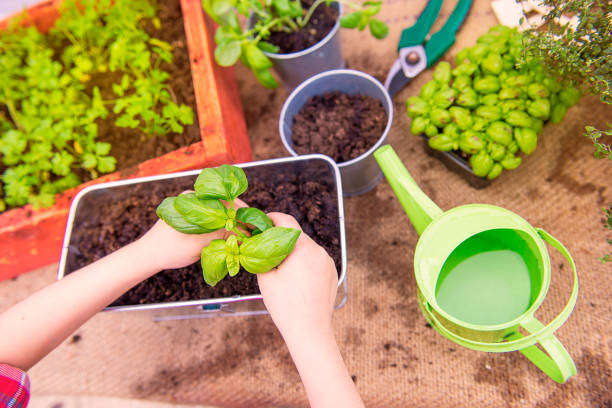
The rapid change in temperature conditions
Basil plant drooping can also occur because of rapid changes in weather conditions because basil is a very sensitive plant that grows worse in tolerating high temperatures and too-cold weather.
If the basil grows outside, then the slightest changes in the weather are reflected in the basil leaves. For example, a sudden cold snap will lead to basil wilting, curling of leaves, or the appearance of brown edges on the leaves.
Due to the decrease in temperature, the evaporation of moisture also decreases. So, the risk of overwatering the basil plant increases. A few days in boggy soil and your basil has root rot.
If the first symptoms of the effect of the plant have already appeared, cut off the injured leaves, carry the basil inside and take care of it carefully for the next few days.
When the weather improves and the basil has recovered a bit, you can bring it outside again.
If there is a heat wave with high temperatures in your region, basil will immediately react to the hot weather by drooping the leaves, which will also lead to wilting.
During high temperatures, evaporation of moisture from the soil occurs faster, and therefore insufficient moisture will immediately turn a healthy basil plant into wilted basil.
Carry the basil indoors, or at least in the shade, to avoid direct sunlight hitting the basil leaves, and their burning and wilting.
Basil should also be watered more often. Watering basil in the morning and evening, pouring water under the roots, not over the leaves, will save your basil plant from hot weather. When the heat wave passes, you can take the basil to its usual place.
Not regular pruning
The next reason for the basil plants wilting is the flowering of the plant. This is a natural process that occurs closer to the end of the growing season. As with all annual plants, the flowering of basil plants is an inevitable process, which is followed by the process of formation and maturation of seeds for further reproduction of the plant.
So, you have to remember that wilted basil is inevitable.
But you can slow down this process by regularly pruning the basil leaves.
Prune regularly your basil, and at the same time watch for the appearance of flowers.
When you notice the first blooms, cut them off. Thus, you will extend the vegetative period of the basil plant, and you’ll always have fresh leaves for your culinary masterpieces. In addition, basil will begin to grow not only in height but in width.
Leggy growth isn’t so good for basil. When the basil grows in width, more leaves will receive full sun and basil will be alike a healthy plant.
It’s worth noting that the flowering of basil is not a disaster. Basil flowers are edible. You can cut them and use them as food, just like the leaves. Besides, flowering is accompanied by the appearance of seeds. Once the seeds are ripe, you can harvest them and use them for the next season.
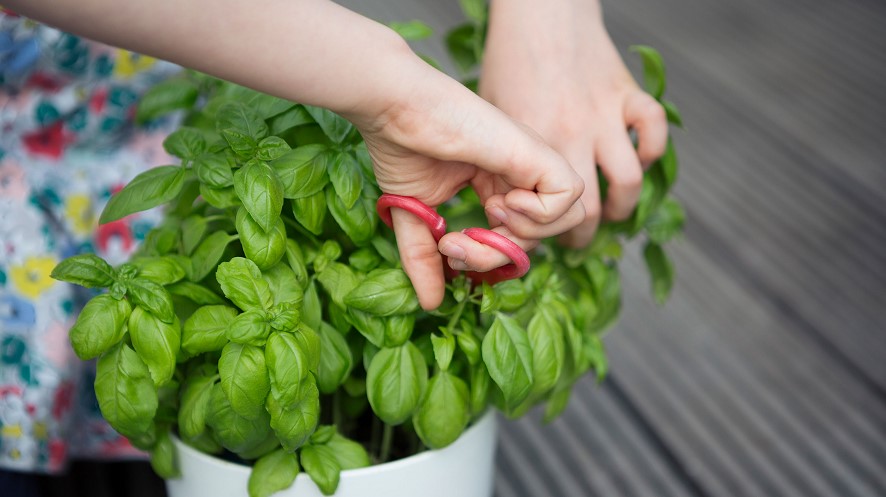
Diseases that affected leaves or roots
Basil plants are very sensitive to diseases. General basil plant diseases are downy mildew, Fusarium wilt, leaf spot, and root rot.
All these listed diseases cause basil leaves to wilt and drying of the plant. Let’s get acquainted in more detail with the manifestations of these diseases and the possibilities of overcoming them.
Downy mildew
Downy mildew is one of the most general fungal diseases of basil. Peronosporosis most often develops in humid conditions with high temperatures. Small light-yellow spots turn up on the leaves. Over time, these spots merge, forming hollow places.
And on the reverse side of the leaves, a white, or gray fungal plaque forms. This plaque can acquire a purple color as well. Leaves die and fall. If you notice the first affected leaves, immediately cut and destroy them. It is not recommended to spray basil with fungicide.
If you understand that wilted basil is seriously affected by downy mildew, the plant will have to be destroyed. Try planting basil of different types (Thai basil, Lemon basil, or purple basil varieties) that are less susceptible to diseases. After all, sweet basil is very disposed to this disease.
Fusarium wilt
Fusarium wilt is the next disease that causes wilting of basil plants. This disease is provoked by a soil pathogenic fungus. The fungal disease affects the roots of plants, slowing their growth and finally stunting them. Then they suddenly wither.
Brown spots or streaks on the stems, decoloration of the inner stem tissue, and sudden leaf drops are the first signs of Fusarium wilt.
If you suppose your basil plant has Fusarium wilt, take away all affected leaves and plants.
Unfortunately, if the soil is infected with Fusarium wilt, there is no treatment, and the basil will have to be decimated. Soil can harbor pathogens for many years, so it’s best to plant basil in new, fresh soil.
To prevent Fusarium wilt in basil plants is to get a basil plant that is stable to the disease, such as Lemon basil or purple basil.
Root rot
Root rot is the next general disease caused by a fungus that attacks the roots of basil plants when it is excessively wet. The basil plant will begin to wilt, and the leaves will turn yellow and then brown before finally falling off the plant.
If you suppose your basil has root rot, allow the soil to dry out completely before watering it again. To prevent basil root rot is to water it only when notice the dry soil.
Leaf spotting
Leaf spot is also a general illness that can bring the basil to wilt. This disease is provoked by a fungus or bacteria that infects basil leaves.
Black or brown spots will appear on the leaves, which will finally wither and fall off.
If you suppose your basil has a leaf spot, take away all affected leaves and destroy them. Water near the base of the plant to prevent leaf spots.
Pests
Not only diseases can affect the basil plant wilting. Pests can also cause issues with the growth of basil.
Spider mites and aphids are more widespread pests that attack basil plants in large numbers, sucking all the juices from the plant. The basil leaves gradually droop, and wither, and finally, the basil plant dries up absolutely.
If you think your wilting basil is infested with aphids or spider mites, sprinkle the plant with water or better with onion peel tincture to remove them. Try using insecticidal soap or neem oil too.
Basil companion plants can also help keep pests away. For example, sweet basil can be planted next to beans, tomatoes, cucumbers, eggplants, zucchini, and pumpkins.
Don’t try planting basil plants with dill, marjoram, and white cabbage. It will be bad for them to grow together, and it’s unlikely that you’ll wait for a nice basil harvest.

Conclusion
Basil plant is excellent not only for food but for the beauty of your garden. Follow some rules and you’ll always have fresh basil leaves. Growing basil under full sun and frequent watering are the best ways. If moist soil isn’t enough, the plant is wilting. A droopy basil plant is not fit for food.
If your basil is wilting, immediately examine the basil plant and discover the reason, for wilted basil leaves.
Dry soil, as well as consistently moist soil, will harm a negative effect on the basil plant. Excess water also collects in the potted basil soil during cold weather or a cold snap.
To avoid waterlogging of the soil, choose the right pots with drainage holes.
If you bring the basil plant from a garden center, don’t forget about a transplant shock and avoid planting basil immediately. Carry the plant indoors and wait a couple of days until the basil recovers.
The rapid change in weather conditions (cold snap/heat wave) will also affect your basil plant.

